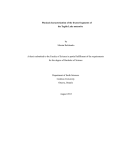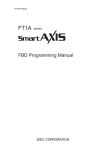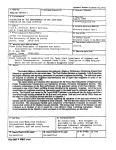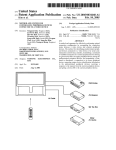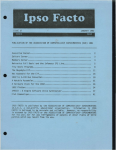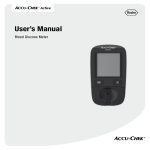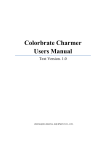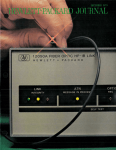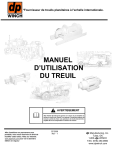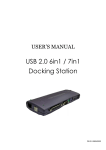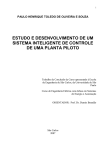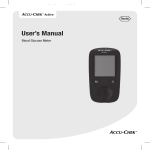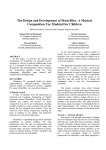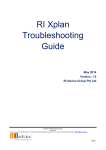Download llllllllllllll|||I|||||||||l|l|||||||llllllllllllllllllllllllllllllllllllll
Transcript
llllllllllllll|||I|||||||||l|l|||||||llllllllllllllllllllllllllllllllllllll US005356144A Unlted States Patent [19] [11] Patent Number: Fitzpatrick et a1. [45] [54] 5,157,602 10/1992 Fields et a1. ...................... .. 364/412 5,665,502 5/1987 Kreisner ....................... .. 273/ 138 A HAND-HELD LOTTERY NUMBER GENERATING DEVICE [76] Inventors: James R. Fitzpatrick, 170 Morning Date of Patent: 5,356,144 Oct. 18, 1994 FOREIGN PATENT DOCUMENTS Dew Le’ StmtfOrd, Cfmn- 06497; 0061052 9/1982 European Pat. Off. ...... .. 273/138A Kevin W. Coyle, 302 Piedmont St., Waterbury, Conn. 06706 Primary Examiner-Jessica J. Harrison 0 Assistant Examiner-Kerry Owens [21] Appl' NO" 917’868 Attorney, Agent, or Firm-Cohen, Pontani, Lieberman, [22] Filed: Pavane Jul. 21, 1992 [51] Int. 01.5 .............................................. .. G06F 1/02 [52] US. Cl. .......................... .. 273/ 138 A; 273/148 R; [57] ABSTRACT [58] 273/ 138 R; 364/412; 364/717 Field of Search ......... .. 273/138 A, 138 R, 148 R, The present mventron 1s a random number generatmg devi¢e (10) for generating a plurality of random num 273/ 146; 364/412, 717 bers. The device comprises means for inputting at least _ _ _ _ one set of user de?ned parameters from which the plu [56] References Cited U.S. PATENT DOCUMENTS 4,692,863 9/1987 M0052 ............................... .. 364/412 4,713,787 12/1987 Rapp ............. .. 4,858,122 4,819,818 4/1989 8/1989 Simkus et ........ Kreisner a1. .. 4,858,931 8/1989 McKechnie . 5,031,914 7/1991 Rosenthal 5,048,833 rality of random numbers are selected. In a preferred embodiment, the device is capable of generating ran 9/1991 which allow a user to input parameters, with the re 273/ 138 A 273/138 A " 273/138 A maining two games capable of generating random num bers akin to numbers generated upon the rolling of a pair of dice and the spinning of a Roulette Wheel. ' Lamle .... .. dom numbers Pursmmt to Six Stored games, four of ______ _, 364/717 273/146 273/138A 5,102,134 4/1992 Smyth ........................... .. 273/138 A 26 Claims, 15 Drawing Sheets STEP I? FRO" FIG 90 GET‘RANDOM‘ VALUE / FROM TABLE 111mm LOAD REGOOWITH MIN [STEP '8 3192p REG(X)= mom 1 -’ RANGE VALUE ‘0'0R '1' 11111111). moo-1 ’5TEP ‘9 STEP 34) CLEAR NUMBERS - FROM DISPLAY STEP 2e PLAY‘ 151131553 'YES STEP 35 YES ‘PLAY’ KEYP'IRESS SEND ' D'SPLMQEFQER \STEP28 1 POINT 10 NEXT VALUE m RANDOM TABLE Am 29 YES POINT TO START OF RANDOM TABLE STEP 5| . US. Patent Oct. 18, 1994 / Sheet 1 of 15 \ f w PERSONAL PICK CORP DEVELOPED for l 9 9 l (C) XYZ CORPORATION ON OF P PLAY GAME YES NO ON OFF PLAY GAME YES NO 51 S2 S3 '54- 55 S8 S1 S2 S3 S4 S5 S8 READY ZERO \ READY ZERO PICK RANGE] FIG. / k I F \ Y PICK RANGE) F/G. 2 f \ PERSONAL PICK TM GAME: 1 SETUP? PRESS Y/N K 5,356,144 PICK: 3 RANGE:O-9 ON OF!’ PLAY GAME YES NO ON OP! PLAY GAME YES NO S1 S2 S3 Sb S5 S6 S1 S2 S3 S4- S5 86 READY ZERO F/6.3 PICK RANGE) \ READY ZERO F/6‘.4a PICK RANGE) US. Patent Oct. 18, 1994 f Sheet 2 of 15 w / \ GAME:2 PICK:4 RANGE:0-9 GAME:3 PICK:6 RANGE:l-44 ON OFF PLAY GAME YES NO ON OFF PLAY GAME YES NO 51 52 53 S‘ S5 S8 S1 $2 $3 56 S5 58 READY ZERO READY ZERO k PICK RANGE \ F/G.4b GAME:4 ON 0!‘? s1 s2_ PICK RANGE) F/6.4c PICK:6 GAMEzS RANGE:l-54 k 5,356,144 ROLL DICE PLAY GAME YES NO ON OFF PLAY GAME YES NO s3 s¢ s: ss s1 sz' 53 5:- ss 55 my zno pxcx Raw F/6.4d \ READY zsao F/6.4e ncx may US. Patent Oct. 18, 1994 / \ Sheet 3 of 15 f # GAME : 6 PRESS PLAY PLAY ROULETTE WHEN READY ON 0?!‘ PLAY GAME YES ‘ NO ON OFF PLAY GAME YES NO S1 S2 S3 S4- S5 S6 S1 S2 S3 84- SS 88 \ READY ZERO PICK RANGE] \ READY ZERO F/6‘.4f _ 08-02-08 PICK RANGE] F/6.5 o1-0s-oo-o3 61 \ 5,356,144 3/9 0 G2 4/9 0 0“ OF!‘ PLAY GAME YES NO ON 0!‘? PLAY GAE! YES NO 51 S2 S3 S4 S5 S8 S1 S2 S3 S4- S5 56 READY ZERO F7660 PICK RANGE-j \ READY ZERO F/6.6b PICK RANGE) US. Patent Oct. 18, 1994 r W Sheet 4 of 15 K i 03-15-07-31-26 40 G3 6/44 1 40-29-42-35-16 02 G4 6/54 1 08 OFF PLAY GAME YES NO ON OF!’ PLAY GAME YES NO S1 S2 S3 54 S5 S8 S1 S2 S3 S4 S5 S6 READY ZERO READY ZEID \ PICK RANGE) \ F/6.6c \ r \ ROLL? [2] [5] Y/N G5 2/611 SPIN? [00] GRN Y/N G6 1/37 0 ON 0!! PLAY Gm YES NO ON 0" m! S1 S2 S3 S4- 55 S6 S1 S2 ' S3 READY ZERO F/6.6e PICK RANGE) F/G.6d r k 5,356,144 PICK RANGE) \ GMB YES B0 S’, S5 55 READY ZERO F/G.6f PICK R5863] US. Patent Oct. 18, 1994 Sheet 5 of 15 x 47-42-18-07-31 22-00 G4 12/50 0 PLAY GAME ‘125 S2 S3 S4 S5 READY ZERO ON 81 \ 56 PICK RANGEJ F / 6. 70 f \ 19-5o-33-os-1o 64 12/50 0 L 0B O" PLAY Gm YES 80 S1 S2 S3 S!’ S5 56 MAD! ZERO F / 6.76 PICK m) 5,356,144 US. Patent Oct. 18, 1994 Sheet 10 of 15 5,356,144 ‘FOR’ (PRESS 'ON' SWITCH) ‘INTIALIZE HARDWARE INTERNAL RAM, REGISTERS & UART I TO FIG 90 'SETUP' SEND OPENING SCREENS 'NORMAL' POLL SYSTEM OPERATION (FIG. I A 2) STEP 70 FOR SERIAL DEVICE YES NOTIFY USER'DISPLAY .fSTEP TI 'COMMUNICATIONS' 'ESTABLISHED' LET SERIAL A DEVICE TAKE CONTROL I SEND MENU TO SERIAL DEVICE SEND FORMAT smms, [WAGES/COLOR) \STEP 74 CARRY OUT REQUEST FROM SERIAL DEVICE T0 SERIAL DEVICE I SEND(CRI& (LF) TO SERIAL. DEVICE STEP 12aJ \STEP 75 US. Patent Oct. 18, 1994 Sheet 11 of 15 5,356,144 STEPIT FROM FIG 90 GET'RANDOM‘VALUE / FROM TABLE RND(X) T LOAD REG(X)W|TH MIN STEPZZ r’ REG(X)= REG(X)+ l - - H RANGE VALUE 0 OR I / ' w RND(X)= RND(X)-1 STEP \8 /STEP '9 STEP 20 STEP 34) CLEAR NUMBERS - SEND '-'TO DISPLAY AFTER \STEP 28 NUMBER POINT T0 NEXT VALUE /STEP 29 IN RANDOM TABLE POINT TO START OF RANDOM TABLE I L STEP 3| US. Patent Oct. 18, 1994 5,356,144 Sheet 13 0f 15 FROM FIG. 9(]—-—-> .OET 'R ANDOM' VALUE FROM TABLE RND(X) /STEP I60 I SEND PROMPT & FORMAT STRING TO STEP ITO DISPLAY LOAD REGIXWITH MIN RANIQE VALUE )STEP '8 I RND(X) = RND(X) ' I JSTEP I9 POINT START RANDOM TABLE TOP OF RANDOM TABLE POINT TO NEXT VALUE IN RANDOM TABLE POINT START RANDOM TABLE TO FIG 90 YES 'SETUP' INOREMENT ‘RANDOM’ REGISTER TABLE VALUES US. Patent Oct. 18, 1994 Sheet 14 of 15 5,356,144 .GET'RANDOM'VALUE FROM FIG 90 FROM TABLE RND(X) V SEND PROMPT & FORMAT STRING T0 DISPLAY i LOAD REG(X)WITH ~ MIN RANGE VALUE ‘0| i REG(X)= REG(X) "I ~ W (X): RNW)" TABLE FOR COLOR /STEP so (37='00‘GRN) & SEND 1+ AND COLOR TODISPLAY /STEP6I REG(X) POINT TO START or RANDOM TABLE ‘3pm Y/N=(YES) INCREMENT 'RANDOM' ‘REGISTER TABLE 7. VALUES N0 FIG. /3 US. Patent Oct. 18, 1994 Sheet 15 of 15 5,356,144 1 5,356,144 2 program a separate set of parameters for each mode and HAND-HELD LOTTERY NUMBER GENERATING DEVICE wherein each set of parameters comprises; (i) a range BACKGROUND OF THE INVENTION struction for allowing duplicate numbers within the I. Field of the Invention This invention pertains to hand-held random number generators for assisting a user in picking random num bers for playing numeric games of chance including Keno, J ai-Alai and various lottery games. More particu larly, the present invention pertains to a hand-held ran dom number generator capable of operating in six from which the random numbers are selected, (ii) a quantity of random numbers selected and, (iii) an in number of random numbers. It is another object of the invention to provide, in addition to the user programmable modes, a ?rst ?xed game for generating random numbers simulating num bers generated upon the rolling of a pair of dice. It is a further object of the invention to provide a second ?xed game for generating random numbers and their corresponding colors akin to the numbers gener and the remaining two of which are factory pro grammed for generating random numbers akin to the 15 ated upon the spinning of a Roulette Wheel. It is a still further object of the invention to provide a numbers generated from rolling a pair of dice and spin ning a Roulette Wheel. portable random number generating device capable of II. Prior Art displaying programmed messages for allowing a user to There are many situations in which it is desirable to determine whether an instant prize has been won. select numbers at random. One such situation is for 20 SUMMARY OF THE INVENTION choosing numbers for various number games, such as lotteries. In this situation, it is desirable for a lottery Broadly speaking, the present invention is a random participant to use a portable or hand-held random num number generating device for generating a plurality of ber generator for choosing random numbers. Several random numbers, comprising: means for inputting at such portable random number generators exist. One 25 least one set of user de?ned parameters for the plurality such device is found in US. Pat. No. 4,858,122 of random numbers, the set of parameters comprising, a (Kreisner). The Kreisner device is capable of operating range having a lower limit de?ning a minimum number in ?ve pre-programmed modes with the user selecting modes or games, four of which are user programmable the upper limit of the range from which the random numbers are chosen. The lower limit of the range is value and an upper limit de?ning‘ a maximum number preset to l. The ?ve pre-programmed modes of this random numbers, and means for optionally precluding duplication of numbers in the plurality of random num bers. The device also comprises means for storing at device allow a user to select a quantity of random num bers ranging from 3 to 6. The Kreisner device is limited value, the amount of random numbers in the plurality of in several respects. For example, if the ?rst mode, which generates 3 random numbers, is selected, the least one set of user de?ned parameters, means respon random numbers chosen are all single digit numbers, i.e. the device does not provide the user with an option for selecting three double digit numbers such as, for exam ple, 12, 2O, 34, etc. This device is also limited by not providing the user with the ability to select more than sive to the set of user de?ned parameters for generating the plurality of random numbers and means for output ting the generated plurality of random numbers. In the preferred embodiment, the device is capable of six numbers at a time. Also, the device does not allow eters as well as generating numbers pursuant to two generating numbers pursuant to the user de?ned param for selecting the minimum value of the range from ?xed modes of operation. These ?xed modes allow for the generation of random number combinations akin to Another portable random number generating device numbers generated upon the rolling of a pair of dice as is found in US. Pat. No. 4,692,863 (Moosz). This device 45 well as the generation of random numbers, and their is capable of operating in a weighted'mode and a ran corresponding colors, akin to numbers generated upon dom mode. When operated in the weighted mode, the the spinning of a Roulette Wheel. which the random numbers are chosen. user enters a plurality of favorite numbers into a mem ory array and some of the random numbers generated are chosen from this array. When operated in the ran dom mode, the device, like the Kreisner device above, is limited in that it only allows the user to select be Also according to the present invention is a method of selecting random numbers from a random number generator for use in various numeric games of chance including Keno, Jai-Alai and various lotteries compris ing the steps of: inputting at least one set of user de?ned parameters, the set of parameters comprising, a range vice is not capable of selecting a quantity of random 55 having a lower limit de?ning a minimum number value numbers greater than six or less than three, thereby and an upper limit de?ning a maximum number value, limiting its uses. an amount of random numbers in the plurality of ran tween a minimum of three random numbers and a maxi mum of six random numbers. In other words, this de As discussed above, the prior art portable random number generators have substantial limited capabilities. dom numbers, and an instruction for optionally preclud ing duplication of numbers in the plurality of random Therefore, it is desirable to have a hand-held random 60 numbers; storing the set of user de?ned parameters, number generating device with user programmable generating the plurality of random numbers responsive capabilities for allowing the user to de?ne a range from which the random numbers will be chosen as well as allowing the user to have full control over the quantity to the stored set of user de?ned parameters, and output ting the generated plurality of random numbers. of numbers generated. Accordingly, it is an object of 65 The foregoing as well as additional details of the present invention will be more fully apparent from the the present invention to provide a hand-held random number generating device comprising multiple separate and distinct modes of operation for allowing a user to following detailed description and annexed drawings of the presently preferred embodiment thereof. 3 5,356,144 BRIEF DESCRIPTION OF THE DRAWINGS FIG. 1 is a top plan view of the device in accordance with the present invention showing an initial message 4 embodiment the maximum upper limit value is ?xed to 99. Games 1 and 2 are pre-programmed with a repeat function, i.e. two or more numbers within the quantity on a liquid crystal display; of numbers chosen in these games may be duplicates. FIG. 2 is a top plan view of the device showing an Conversely, games 3 and 4 are pre-programmed with a other message on the liquid crystal display; non-repeat function, i.e. no two numbers within the FIG. 3 is a top plan view of the device showing a user quantity of random numbers generated in these games prompt message on the liquid crystal display; will be duplicates. Furthermore, game 5 has pre-pro FIGS. 4a—7b are top plan views of the device show 0 grammed parameters for generating random numbers ing various messages displayed on the liquid crystal akin to numbers generated upon the rolling of a pair of display; dice. Game 6 likewise has pre-programmed parameters FIGS. 8a-8c are schematic diagrams of the present for generating random numbers akin to numbers gener ated upon the spinning of a Roulette Wheel. The colors invention; FIG. 9a is a ?ow chart showing the “power-on/re red, black and green corresponding to the numbers set” function of the device software; generated from game 6 are also displayed. FIG. 9b is a flow chart of the device software opera Referring now to FIGS. 8a-8c, a schematic diagram tion for a host/slave con?guration; of the circuitry of the device is provided. The circuit of FIG. 10 is a flow chart of the device software opera FIG. 8a performs the power on, memory backup, auto tion for games 1 and 2; matic shut-off and voltage regulator functions. As FIG. 11 is a ?ow chart of the device software opera shown, the device is powered by a 9 volt battery BT1, tion for games 3 and 4; but an alternative power supply may be substituted FIG. 12 is a flow chart of the device software opera therein. For example, a solar cell or an AC adapter may tion for game 5; be used and, to accommodate the later, an AC power FIG. 13 is a flow chart of the device software opera 25 tion for game 6; FIG. 14 is a perspective view of the device in accor jack (not shown) is provided. The voltage regulator circuit utilizes microchip U1 which, when con?gured as shown in FIG. 80, supplies a constant 5 volts to the remainder of the device circuitry of FIGS. 8b and 8c. dance with the present invention; FIG. 15 is a top plan view of the device shown in In FIG. 8b, the microcontroller chip U2 is shown 30 interfaced with a clock circuit Y1 and a liquid crystal FIG. 14; and FIG. 16 is a side view of the device shown in FIG. 14. display LCD1. Pins POO-P07 are pulled up to 5 volts through resistor bank RAlA to prevent them from DETAILED DESCRIPTION OF THE ?oating. The random numbers are generated by a mi PREFERRED EMBODIMENT crocontroller U2 which contains read only memory Referring now to the drawings and initially to FIGS. (ROM) for storing the instructions for generating ran 14-16, the device in accordance with the present inven dom numbers. The read only memory (ROM) also tion is generally designated at 10. The device 10 has a stores the parameters for playing games 5 and 6. The housing 12 in the shape of a conventional pocket calcu microcontroller U2 also contains random access mem lator having a front face portion 14. As shown, the ory (RAM) for storing user inputted parameters for device 10 has an output device, such as a liquid crystal 40 playing games 1-4, variable tables and areas required display 16, and an input device, such as six user acti for microcontroller U2 operation. It should be readily vated function keys, 81-86. It will be appreciated, that apparent to those of ordinary skill in the art that mi other suitable means can be utilized as input devices or crocontroller U2 can be substituted with a microproces output devices. The function keys are shown positioned sor interfaced with external (RAM) and (ROM). Due to in two columns in FIG. 14 but may also be positioned in 45 the memory backup circuit, shown in FIG. 8a, the mi a row along the bottom of the front face portion 14 of crocontroller random access memory (RAM) continues housing 12, as shown in FIGS. 1-7b. Also as shown, to retain data inputted therein as long as power remains function keys 81-86 have instructional words in prox connected to the microcontroller U2, i.e. even if func imity thereto, with some keys assigned one or two func tion key S2 (off) is selected. tions depending on which mode or game the device is The device provides an input/output port for inter operated in. For example, function key S1 turns the facing with external items such as printers and comput device on whereas function key S3 performs both the ers (not shown). Speci?cally, a standard RS232, which “play” and “zero” functions. The use of the function is known to one of ordinary skill in the art, is shown in keys will be more fully explained below. FIG. 8c. However, as can be readily appreciated, other The device 10 is capable of operating in six separate means for interfacing can be provided such as a stan and distinct modes or games. Games 1-4 are user pro dard RS422/485 interface for interfacing the device grammable in that the user inputs different sets of user with multiple printers and/or computers. When inter de?ned parameters for governing the random numbers faced, the device communicates with these items as selected in each game. Each set of user-de?ned parame shown in the ?ow chart of FIG. 9b which will be dis ters consists of a range from which the random numbers cussed hereinbelow. are chosen as well as a quantity, i.e. the amount of ran While the information depicted in the flow charts in dom numbers chosen. The range has an upper limit FIGS. 9a-13 will be readily understood by those of de?ning the maximum number value and a lower limit ordinary skill in the art, a brief description of the device de?ning the minimum number value. The lower limit is nonetheless herein provided. With reference to FIGS. can be any value but in the preferred embodiment, the 65 1-7b and the ?ow chart of FIG. 9a, power is supplied to lower limit may be adjusted to either of 0 and l. The the device by selecting function key S1 (on) (see step 1 device has the capacity for allowing the upper limit to of FIG. 9a). The microcontroller brie?y runs through a be between the lower limit and 1037 but, in the preferred series of diagnostic tests and then displays a series of 5 5,356,144 messages on the liquid crystal display 16 as shown in steps 2 and 3. The ?rst message is shown in FIG. 1. This message is displayed for a predetermined time and is followed by a second message shown in FIG. 2. Like 6 Referring now to FIG. 10, the random number gener ating software will now be described. Note that FIG. 10 depicts the steps performed for generating random numbers according to games 1 and 2, i.e. “repeat” games. FIG. 11, on the other hand, depicts the steps performed for generating random numbers for games 3 mined time and then changes to the user prompt mes and 4, i.e. “non-repeat” games. As the steps in FIGS. 10 sage shown in FIG. 3, (see step 4 of FIG. 9a). This and 11 are nearly identical with the exception of the message remains displayed until the user inputs the “non-repeat” steps of FIG. 11, the steps of FIG. 10 will desired instruction, i.e. (yes/no). Front step 4, the user may choose between playing 10 now be discussed and only the “non-repeat” steps of FIG. 11 will be discussed below. the previously played game or, in the alternative, enter As shown in FIG. 10, step 17 retrieves the current ing the “setup” mode. The “setup” mode is entered by wise, this message is displayed for another predeter selecting function key S5 (yes/pick) thus allowing the random number from a random number table stored in user to enter user-de?ned parameters into the device such as the amount of random numbers desired and the register RND(x). Step 18 loads register REG(x) with the microcontroller (RAM). This value is stored in the minimum range value, i.e. 0 or 1. The loop com prised of steps 19—22 function as shown and the current range from which these numbers are chosen, (see steps 6, 7 and 8 in FIG. 9a). If, however, the function key S6 (no/range) is selected (step 10), the user enters the “play” mode wherein the random numbers selected will be in accordance with the last game played. Note that when the device is awaiting user interaction, the ran dom register table values, front which the random num value stored in register REG(x) when register RND(x) equals zero is displayed on the liquid crystal display 16 as shown in step 23. When this value of register REG(x) is displayed, if this is the ?nal number in the amount of random numbers generated, steps 24,25 and 26 will be performed. Since, in the preferred embodiment, the liquid crystal display 16 is only capable of displaying up bers are generated, continue to be incremented as shown in steps 14 and 15 of FIG. 90. Assuming function key S5 (yes/pick) is selected, the 25 to 7 random numbers at a given time, if the value of register REG(x) displayed is less than the amount of “setup” mode will now be discussed with reference to FIG. 9a. The “setup” mode allows the user to de?ne the numbers chosen and the amount of numbers chosen is less than 7, a dash (—) is displayed on the liquid crystal display after the generated number, a new random num parameters of each game by performing a series of steps. It should be remembered that, of the four. programma~ 30 ber is stored in register RND(x) and the series of steps ble games, only games 1 and 2 are capable of generating is repeated for generating the remaining numbers in the repeat numbers wherein games 3 and 4 are incapable of amount of random numbers. Note that if the amount of generating repeat numbers. Therefore, if the user random numbers is greater than 7, steps 32-34 will be wishes to generate repeat numbers, function key S4 performed after step 27, thereby displaying the remain (game) will be selected for displaying games 1 or 2 as ing numbers. shown in FIGS. 4a and 4b. Function key S4 (game) This is further illustrated in FIGS. 70 and 7b. In these scrolls through all 6 games. Therefore, if the device is ?gures, FIG. 7a displays random numbers generated displaying game 6 and function key S4 is selected, the from game 4, a “non-repeat” game, wherein the number device wraps around to game 1. This is shown in steps of random numbers is 12, the maximum range value is 6 and 11 of FIG. 9a. 50 and the minimum range value is 0. FIG. 7a displays Assuming game 1 is selected, the user will then input the ?rst seven numbers. To display the remaining ?ve the parameters, i.e. the range from which the random numbers as shown in FIG. 7b, function key S3 (play) is numbers will be generated and the amount of random selected. These ?ve numbers remains displayed until numbers. The number of random numbers is selected by function key S3 (play) is again selected thereby chang using function key S5 (pick), (step 8 of FIG. 9a). Each 45 time S5 (pick) is selected, the amount of random num bers is incremented by one. This number will reach a maximum value of 99 and then wrap around to the numeral 1, as shown in step 12. The range is selected in a similar fashion utilizing function key S6 (range), (step 7 of FIG. 90). When S6 is selected, the upper limit of the range representing the maximum number value of ran dom numbers generated, is set. The upper limit is incre mented by one until a maximum value of 99 is reached whereupon the maximum value wraps around to the 55 numeral 1, as shown in step 13. The lower limit of the ing the liquid crystal display to the message shown in FIG. 3. From this point, the user may either (i) select another twelve random numbers in game 4 by selecting the function key S6 (no), thereby prompting the user (FIG. 5) to select function key S3 (play), (ii) select function key S5 (yes) thereby changing the parameters in game 4, (iii) choose a different game by selecting function key S4 (game) or, (iv) the user may enter the “setup” mode and input a new set of user de?ned pa rameters which will automatically replace the existing parameters for that game. Referring now to FIG. 11, the “non-repeat” function range is selected by utilizing function key S3 (zero). of games 3 and 4 will now be described. As shown, after This key toggles the lower limit of the range to either 0 step 20 is performed and a random number is selected, or 1. steps 23a and 23b are performed which compare the Once these parameters are inputted, the user exits the 60 selected number to the previously selected numbers in “setup” mode and enters the “play” mode by selecting function key S2 (ready), (step 9). When in the “play” mode, function key S3 (play) is selected, thereby per forming step 16 and the corresponding steps 16a- 16f the amount of random numbers selected. This is accom plished by electronically marking the numerical value in the repeat number table when that particular numeri cal value is generated. Therefore, and as shown in FIG. depending on which game is selected, whereupon the 65 11, if a third random number in an amount of random microcontroller generates random numbers according numbers is chosen, before that number is displayed on to the inputted parameters and these numbers are dis the liquid crystal display, that number is compared to played on liquid crystal display 16. the previous two numbers displayed to determine if this 7 5,356,144 8 on the liquid crystal display 16, as shown in FIG. 6f and third number is a duplicate of either the ?rst or second number. If it is a duplicate, another random number is as described in step 61 of FIG. 13. After each number is generated and again compared to the previous two numbers. If this other number is unique from the previ displayed, the user may “spin” again, (step 62) or return to the “setup” mode. ous two numbers, it is displayed. If not, the loop is again As explained above, the device provides an input repeated. /output port for interfacing with an external computer. A further illustration of this process will now be In other words, the device may be operated in a “host” described by referring to FIGS. 4c and 6c. In FIG. 4c, or “slave” mode. This operation is depicted in the ?ow game 3 is selected, the number of random numbers chart of FIG. 917. As shown, after the device ?rmware chosen is 6 and the range has a maximum number value 10 is initialized, step 70 is performed which searches the of 44 and a minimum number value of 1. Once the user input/output port for serial devices. If a serial device, de?ned parameters are inputted, the setup mode is ex~ such as a computer, is present, step 71 displays the ap ited by pushing function key S2 (ready) and random propriate message on the liquid crystal display 16. If the numbers are generated by selecting function key S3 device is to be operated in a “host” mode, steps 72, (play). When function key S3 (play) is selected, the 72a-72d are performed. If, however, the device is to be microcontroller will select six random numbers within operated in a “slave” mode, steps 73-76 are performed. the range 1-44 and will display the results on the liquid In a preferred embodiment, the device will be avail crystal display 16 as shown in FIG. 6c. As shown, the able nationwide and/or worldwide and, the device will six random numbers are displayed with dashes separat contain default values comprised of pre-programmed ing them from adjacent numbers, (step 28 of FIGS. 10 and 11). Also displayed is “G3” representing game 3, “6/44” representing the quantity of numbers (6), the 20 parameters for some of games 14. These pre-pro grammed parameters will correspond to the lottery con?gurations in the areas which the devices are sold. For example, devices sold in the New York area will be pre-programmed for New York lotteries such as Since game 3 is a “non-repea ” game, the set of six 25 “LOTTO”, where six “nonrepeat” numbers are chosen numbers generated will contain no duplicates. In con from a range of 1-52. A user may choose random num trast, and as shown in FIG. 6a, the results of playing bers according to these parameters by merely selecting game 1 having a number of random numbers equal to the corresponding game 1-4 as explained above. These three and a range with a maximum number value of 9 and a minimum number value of 0, is depicted. Note 30 pre-programmed parameters will be automatically re placed when a user inputs his own user-de?ned parame that of the three numbers generated, two of them are maximum number value of the range (44), and “1 “, representing the minimum number value of the range. duplicates. ters. Referring now to FIGS. 4e, 6e, 9a and 12, game 5 “dice” will now be described. As shown in FIG. 9a, mass produced and will be accompanied by a user man after step 4 is performed, step 5 is performed which displays the screen shown in 4e. Next, and as shown in FIG. 12, after step 17 is performed, step 17a is per formed which displays the message shown in FIG. 6e. Also in a preferred embodiment, the devices will be 35 ual containing instructions for device operation. As an alternative to consulting the manual, the device will contain an on-line help feature for accessing frequently referenced user manual instructions which are perma nently stored in the microcontroller memory. Further As game 5 is a “dice” game, the amount of random numbers selected is 2 and the range from which these 40 more, the device will, in itself, be a form of lottery. This will be accomplished by pre-programming some of the numbers are selected has a minimum value of l and a mass-produced devices with a plurality of messages to maximum value of 6. The minimum range value is loaded into register REG(x) as shown in step 18 of FIG. be displayed when accessed by the user. Some of these messages will correspond to a plurality of instant-win 12. The two random numbers are generated in an identi cal manner as explained above with the exception of 45 prizes. The accompanying user manual will contain a step 20a, i.e. stripping the leading zero away from the random numbers generated. As shown in FIG. 62, the two random numbers generated are displayed as single digits enclosed in brackets. Once both numbers are look-up table listing all the pre-programmed messages and their corresponding prizes. A user will access the pre-programmed messages and consult the user manual to determine which prize has been won. The device will displayed, the device allows the user to select between 50 also possess multi-lingual capabilities for communicat ing in a plurality of languages. returning to the “setup” mode or playing game 5 “dice” Although I have herein shown and described the again. preferred embodiment of the invention, various changes Referring now to FIGS. 13, 4f and 6f and as stated and modi?cations will be readily apparent to those of above, game 6 generates numbers and their correspond ing colors similar to the numbers and colors generated 55 ordinary skill in the art who read the foregoing descrip tion. For example, a microcontroller with extended upon the spinning of a Roulette Wheel. This is accom plished by performing the steps described in the flow chart of FIG. 13. When game 6 is played, the number chosen is displayed with a three character designation corresponding to the colors RED, GREEN and memory capabilities may be utilized thereby increasing the quantity of user-programmable games and a key board may be utilized instead of the function keys S1—S6 for inputting user de?ned parameters. As these as well as further changes and modi?cations are intended to be within the scope of the present inven tion, the forgoing description should be construed as illustrative and not in a limiting sense, the scope of the BLACK, i.e. RED, GRN, BLK. This is accomplished by comparing the number generated to a look-up table stored in the microcontroller ROM (step 60 of FIG. 13). The look-up table lists the Roulette Wheel numbers 0-37, with the value 37 being assigned the value ()0, and 65 invention being de?ned by the following claims. What is claimed is: their corresponding colors. When the generated num 1. A hand-held random number generating device for ber matches the identical number on the look-up table, this number and its corresponding color are displayed generating a plurality of random numbers having at






















